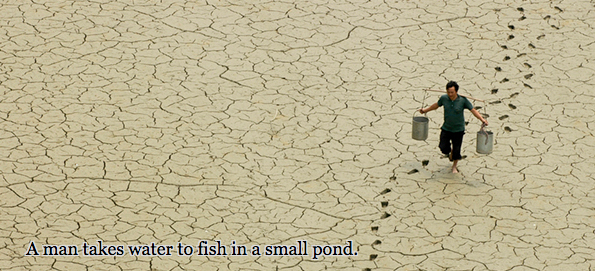Lesson Plan For Types of PIC-LITS: Captions Level 2
OBJECTIVE:
A caption is a short description accompanying a photograph.
Writing captions assumes a three part process for the reader. They look at the photograph, read the caption, and then return to photograph to see it in the context of the new information they learned from the caption.
YOUR CAPTION SHOULD:
- explain the photograph,
- identify the context from left to right,
- intrigue the reader / viewer to see the photograph anew.
- use present tense to describe action in a photo.
- give readers information they cannot get from just looking at a photo.
- complete the photograph.
- start from specific to general or general to specific.
- not use “Above” and “pictured here”.
We will learn how to write intriguing captions by using PIC-LITS.
MODEL PIC-LIT:

This caption explains what the man is doing, explains that there is water in the buckets, identifies where he is taking the water, and intrigues the reader to see the photograph in a new way.
GUIDED PRACTICE WRITING PROMPT:
- Go to piclits.com
- Sign in with your e-mail and password
- Select a picture from the gallery of pictures
- In FREESTYLE mode, write a caption at the bottom of the photograph that explains the photograph, identifies the context, and intrigues the reader to see the photograph in a new way.
When someone looks at a picture, they’ll look at the caption for the specifics (name, place, context), but every caption should also intrigue in a way that makes them look back at the picture because they just learned something they didn’t know before they read the caption. If the picture and caption work well together, they’ll look at the headline and then the story.National Geographic captions are excellent examples. As a strategy, the captions work from either specific to general, or general to specific. They intrigue you, and make you want to read the story. BINGO! People look at the photograph first, then the caption, then back to the photo as they become intrigued, and then to the story. And the story better be ready to reward them immediately for taking a chance and glancing at the first paragraph or two.
WRITING CAPTIONS:
- Do not begin with the words a, an or the.
- Use present tense to describe action in a photo.
- Give readers information they cannot get from just looking at a photo.
- A caption should complete the photo. The reader should not have to look at the story, but should want to look at the story.
- Write captions so they go from specific to general or general to specific.
- Do not begin a caption with names.
- When identifying members of a group, write “from left,” not “from left to right.”
- “Above” and “pictured here” are unnecessary.
- Captions should not repeat information contained in the lead.
- Name people only if they are important to the picture.
Vary the way you begin captions:
- prepositional phrases
- infinitive -phrases
- participial phrases
- adjective phrases
- questions
- exclamations
- play on words
ACTIVITIES
- Cut out pictures from magazines and newspapers that set a mood or seem to tell a story. Practice writing story captions for these pictures.
- Review copies of National Geographic captions and discuss how much of the information identifies what is in the photograph, and how much of the information extends beyond the photograph to other elements of the story.
- Have the staff cut out photos with captions that are good models. Keep them in a notebook or post them on the bulletin board. Analyze what makes each one effective and interesting.
